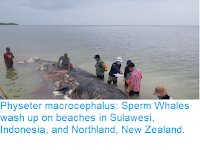The Monodontidae is a highly distinctive group of Toothed Whales, with two living species, the arctic Narwhal and the subarctic Beluga Whale. The group also contains three previously described fossil species, from the Miocene and Pliocene, one from each coast of North America and one from Japan, all interpreted as having lived in cool temperate waters, although each of those is known only from single, fragmentary specimens, so the history of the group is not well understood.
In a paper published in the Journal of Vertebrate Paleontology on 22 August 2019, Giovanni Bianucci, Fabio Pesci, Alberto Collareta, and Chiara Tinelli of the Dipartimento di Scienze della Terra at the Università di Pisa, describe a new species of Monodontid Whale from the Early Pliocene Arcille Assemblage of Campagnatico in Grosseto Province, Tuscany.
The Arcille Assemblage derives from a quarry in the Baccinello-Cinigiano Basin, where a shallow marine sedimentary sequence has produced a variety of Vertebrate fossils, including Dugongid Sirenians, Billfish and Sharks, as well as an invertebrate fauna dominated by large Clams and Scallops, as well as a variety of other Molluscs, Echinoderms, Bryozoans, and Corals.
The new species is named Casatia thermophila, where 'Casatia' honours Simone Casati a prominent amateur palaeontologist who discovered most of the fossil Vertebrates from Arcille, and is the author of several academic and popularising works on the Pliocene marine vertebrates of Tuscany, and 'thermophila' means 'lover of warmth' in reference to the presumed climate in which the Arcille assemblage was deposited. The species is described from a fragmentary cranium, which consists of well-preserved, rather unrealised bones that appear undeformed. The best-preserved portion of the cranium is the dorsal surface of the neurocranium, including both premaxillae, part of the left maxilla, a smaller portion of the right maxilla, the right nasal bone, and the presphenoid. The rostrum is completely missing. This is unambiguously assigned to Monodontidae based on the presence of a medial exposure of the maxillae anterior and lateral to the external bony nares
Casatia thermophila. Skull in (A), (B), dorsal and (C), (D), right lateral views. Diagonal lines represent broken surfaces. Abbreviations: bn, bony nares; cc, concretion; cp, cribriform plate; ns, nasal; psf, premaxillary sac fossa; soc, supraoccipital. Bianucci et al. (2019).
The discovery of a Monodontid Whale in the Arcille Assemblage has important implications for the history of the group. The Arcille Assemblage is interpreted as having been laid down in a deltaic environment in a warm climate, and had produced numerous unambiguously warm water fossils, such as Sirenians and Billfish. This is in contrast to the distribution of modern Monodontid Whales, which are found exclusively in the arctic and subarctic waters of the Northern Hemisphere. None of the previously described fossil species comes from the Arctic, but neither do they come from unambiguously warm water deposits, which has led to a tendency to assume that the group always favoured cooler waters, something which can now be demonstrated to be inaccurate.
Life reconstruction of Casatia thermophila, swimming in the coastal waters off present-day Tuscany in Early Pliocene times (5.1–4.5 million years ago). Behind the Cetacean, two individuals of the Sirenian Metaxytherium subapenninum are approaching the shallow sea floor, likely attracted by the presence of abundant Seagrasses. The coexistence of Monodontids (Casatia thermophila) and Sea Cows (Metaxytherium subapenninum) in the warm marginal marine waters of the central Mediterranean Basin during the Early Pliocene reflects the composition of the fossil vertebrate assemblage from Arcille, where a Sirenian specimen was collected from the same horizon as Casatia thermophila. Alberto Gennari in Bianucci et al. (2019).
See also...
Follow Sciency Thoughts on
Facebook.








